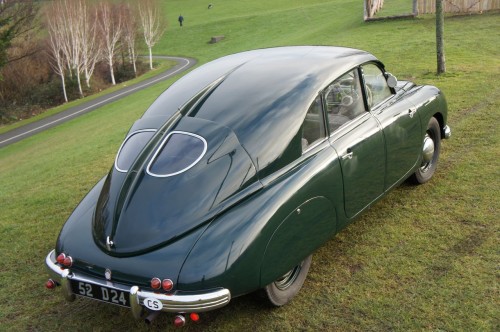
Click Here for Full Screen Image - Click Here to Download Image
 |  |  |  |  | |||||
 |  |  |  |  | |||||
 |  |  |  |  | |||||
 |  |  |  |
| Lot number | 88 |
|---|---|
| Hammer value | N/S (est. £35,000 - £40,000) |
| Description | Tatra Tatraplan T600 |
| Year | 1952 |
| Colour | Green |
| Engine size | 1,950 cc |
| Chassis No. | 180288 |
| Engine No. | 600 3732 85 51 |
Austrian-born Hans Ledwinka started his illustrious career as a trainee engineer, moving to nearby Vienna to continue his studies.
His first full-time employment was with Nessledorfer-Wagenbaum, manufacturers of railroad stock. Their first primitive car, the President, arrived as early as 1897 and Ledwinka was instrumental in developing their new models until leaving for Austrian competitor Steyr, where he worked alongside Ferdinand Porsche in 1917.
Four years later he had been coaxed back to the firm, this time as chief engineer, the company now calling itself Tatra, a name which it took from a nearby mountain range. New models quickly came and went, the seminal T77 arriving in 1933, it’s fabulous V8 air-cooled engine hiding at the rear.
The unrestricted autobahns spreading all over Germany needed powerful streamlined cars, Ledwinka’s answer being to employ Hungarian-born Paul Jaray, the designer of the teardrop Zeppelin airships, to pen a low-slung slippery body which dictated placing the engine in the tail. Early models even had a central driving position – eat your heart out McLaren.
Its replacement, the much improved T87 arrived in 1938, the big V8 Tatras being used exclusively by high ranking military and government officials or exported in a bid to obtain valuable foreign exchange. The superb high-speed abilities of the V8 Tatras had not gone unnoticed in Germany. Adolf Hitler had enjoyed riding in them and made a point of meeting Ledwinka on a number of occasions and is reputed to have said “this is the car for my roads”. When Ferdinand Porsche was asked to design the KDF Volkswagen, he took what he needed from Ledwinka’s original ideas.
After the war, Ledwinka was accused of collaboration and jailed for five years. Tatra resumed production of the T87 in penny numbers while the emerging centrally planned economy decided what to do next. First priority was to introduce a car that could be mass-produced and was more in keeping with the government’s post-war theme of austerity.
The resulting new Tatraplan T600 had a monocoque body on a punt-like chassis, retaining the tubular backbone from the previous models. An air-cooled four-cylinder engine was chosen with overhead cams driven by chains.
Prototypes suffered from poor cooling and a weak heater (a bad thing in any Eastern Bloc country) and after much head-scratching the design team made several clandestine visits to Ledwinka’s prison cell for advice. Only too pleased to bring himself back in favour with the authorities, he suggested numerous changes, including increasing the engine size to 1,952cc, adding roof vents for better cooling and that distinctive rear fin for stability, all of which must have cheered him greatly. Not long after, he was released from prison and moved to Munich where he lived until the ripe old age of age of 89, driving his favourite Tatra T87 to the end.
The Tatraplan T600 was brilliant, its drag co-efficient of just .32 gave an autobahn maximum of well over 80mph, the short stoke engine coping with full-throttle use without complaint. The weight distribution of 45% front and 55% rear was the best it had been and 4,242 were made at the Tatra plant before production was moved, lock stock and barrel, to state-owned Skoda in 1951 who added a further 2,100 to the tally. Most of these Skoda built cars were exported, the car finding markets in pretty well every country around the world except the UK where it was never officially on sale.
This 1952 RHD example was acquired by a senior VW employee while working at the Skoda factory following their merger in 1990. He commissioned its restoration by a local Czechoslovakian expert, Klaus Stuken, in 1996, having yet more work carried out by Peter Bazzile from Cologne upon his return to Germany a year later.
Other than a modern Eberspacher petrol-powered heater under the rear seat (replacing the original unit which enabled the chauffeur to keep warm while his Communist bosses attended lengthy vodka-fuelled Politburo meetings), it is to standard specification.
Used for various retrospective rallies, it has a FIVA registration card (now expired) and comes with a factory parts book, workshop manual and a small box of useful parts. Currently registered in Ireland, its German papers are also on file. Described by the vendor as being “in lovely condition throughout”, it won ‘Best Post-war Saloon’ at Dublin’s Terenure classic car show last year.
Rare and fascinating, these iconic Tatras just ooze Cold War charisma and very seldom come onto the market, making the fact that we have two in our sale today all the more remarkable. This beautifully restored example looks extremely good value, especially when one considers the fancy prices now being achieved for its T77 and T87 ‘aerodynes’ predecessors.
It may interest bidders to note that this car can be seen in action, driving around the streets of Dublin, by viewing the online video https://vimeo.com/118545096